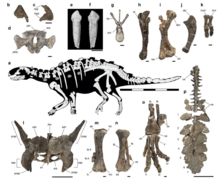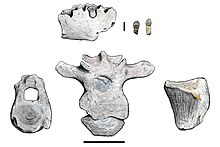Parankylosauria
| Parankylosaurs Temporal range: Cretaceous,
| |
|---|---|

| |
| Fossil material of Stegouros, a parankylosaur | |
| Scientific classification | |
| Kingdom: | Animalia |
| Phylum: | Chordata |
| Clade: | Dinosauria |
| Order: | †Ornithischia |
| Clade: | †Thyreophora |
| Suborder: | †Ankylosauria |
| Clade: | †Parankylosauria Soto-Acuña et al., 2021 |
| Subgroups | |
Parankylosauria is a group of basal ankylosaurian dinosaurs known from the Cretaceous of South America, Antarctica, and Australia. It is thought the group split from other ankylosaurs during the mid-Jurassic period, despite this being unpreserved in the fossil record.[1]
History of research[]

During the Mesozoic era, the southern continents (South America, Antarctica, Australia, and Africa in addition to India and Zealandia) were unified into a supercontinent known as Gondwana. This was in contrast to the supercontinent of Laurasia in the Northern Hemisphere, with both originating from the breakup of Pangaea. Gondwana itself gradually split apart over the course of the Jurassic and Cretaceous eras.[2] Ankylosaurian dinosaurs from Laurasia have historically been far more extensively recorded and studied. Reports of the group in Gondwana date back to 1904, with a specimen from Australia and include referrals of Loricosaurus, Lametasaurus, and Brachypodosaurus to group among assorted fragmentary material.[3] Much of this material including would later be shown to be misidentified and not belonging to ankylosaurs, including the named genera.[3][4][5] The first definitive ankylosaur to be recognized from Gondwana was discovered in Australia in 1964 and later named in 1980 as Minmi paravertebra.[3] The validity of this taxon, as well, has been challenged, though it is remains recognized as an ankylosaurian. The possibility of a biogeographic connection between South America and ankylosaurs in Australia was raised alongside discovery, though based on conjecture.[6]
Ankylosaurs from Gondwana have remained very mysterious. Fossil material continues to be scant and southern taxa have been difficult to interpret in a phylogenetic context. Vertebrae of Antarctopelta from Antarctica, for example, were so foreign compared to those of euankylosaurs that it was questioned if they might instead belong to a marine reptile, which would make the genus based on a chimeric specimen. The discovery of the genus Stegouros, published and named in 2021, helped to clear up the previous confusion. The type specimen of the genus preserved enough of the skeleton to make it clear that there was a previously unrecognized monophyletic grouping of these southern ankylosaur taxa. Thus the study naming the genus, by Sergio Soto-Acuña and colleagues, coined Parankylosauria based on the two aforementioned genera and Kunbarrasaurus. The name, referencing its parent group, means "at the side of Ankylosauria".[1]
Anatomy[]


Known members of Parankylosauria are all small animals, ranging from 1.5–4.0 metres (4.9–13.1 ft), and possessed proportionally large skulls. The most distinctive trait of the group is their macuahuitl, named after the mesoamerican weapon of the same name. This trait is similar to the thagomizer of stegosaurs and tail clubs known in ankylosaurines, though evolved independently from each. This was a structure at the end of the tail formed by a series of five pairs of robust osteoderms (bones in the skin) fused together, surrounding the sides of the tail and surrounding the entirety of it near the tip. This weapon is known directly in the genus Stegouros, suspected based on indirect evidence in Antarctopelta, and not confirmed in Kunbarrasaurus, for which a complete tail is not known. In the former taxon the weapon is associated with dramatic shortening of the tail, made up of far fewer vertebrae than any other kind of thyreophoran. As with many other members of this group, osteoderms would have covered much of the body of parankylosaurs, functioning as spiny armor.[1]

Parankylosaurs, compared to the more well studied euankylosaurs, retain more traits seen in more primitive thyreophorans and stegosaurs. This is most applicable in the body, most distinctively seen in the possession of rather long and slender limbs. The skull, comparatively, is more similar to that of other ankylosaurs, thought to indicate the acquisition of advanced skull traits earlier in ankylosaur evolution. Also unlike euankylosaurs, it is thought, based on the preserved osteoderms of Kunbarrasaurus and lack of flank osteoderms associated with other known genera, that parankylosaurs may not have had rather light coverings of dermal armor compared to their relatives. They possessed a pelvic shield, formed from a thin sheet of bone over the hip region, more reinforced than the superficial shielding of stegosaurs but not as overbuilt as those found in euankylosaurs.[1]
Classification[]


The clade is phylogenetically defined as all taxa closer to Stegouros than to Ankylosaurus, making it a counterpart to Euankylosauria, which has the opposite definition. The following cladogram is reproduced from the phylogenetic analysis in the 2021 study by Sergio Soto-Acuña and colleagues:[1]
| |||||||||||||||||||||||||||||||||||||||||||||||||||||||||||||||||||||||||||||||
See also[]
References[]
- ^ a b c d e Soto-Acuña, Sergio; Vargas, Alexander O.; Kaluza, Jonatan; Leppe, Marcelo A.; Botelho, Joao F.; Palma-Liberona, José; Simon-Gutstein, Carolina; Fernández, Roy A.; Ortiz, Héctor; Milla, Verónica; et al. (2021). "Bizarre tail weaponry in a transitional ankylosaur from subantarctic Chile". Nature. 600 (7888): 259–263. doi:10.1038/s41586-021-04147-1. PMID 34853468. S2CID 244799975.
- ^ "Gondwana". Encyclopaedia Britannica. Retrieved 13 December 2021.
- ^ a b c Molnar, R.E. (1980). "An ankylosaur (Ornithischia: Reptilia) from the Lower Cretaceous of southern Queensland". Memoirs of the Queensland Museum. 20: 65–75.
- ^ Lamanna, Matthew C.; Smith, Joshua B.; Attia, Yousry S.; Doson, Peter (2010). "From dinosaurs to dyrosaurids (Crocodyliformes): removal of the post-Cenomanian (Late Cretaceous) record of Ornithischia from Africa". Journal of Vertebrate Paleontology. 24 (3): 764–768. doi:10.1671/0272-4634(2004)024[0764:FDTDCR]2.0.CO;2.
- ^ Salgado, Leonardo (2013). "Considerations on the bony plates assigned to titanosaurs (Dinosauria, Sauropoda)". Ameghiniana. 40 (3): 441–456.
- ^ Arbour, Victoria M.; Currie, Philip J. (2015). "Systematics, phylogeny and palaeobiogeography of the ankylosaurid dinosaurs". Journal of Systematic Palaeontology. 14 (5): 1. doi:10.1080/14772019.2015.1059985. S2CID 214625754.
- Ankylosaurs
- Albian first appearances
- Maastrichtian extinctions

